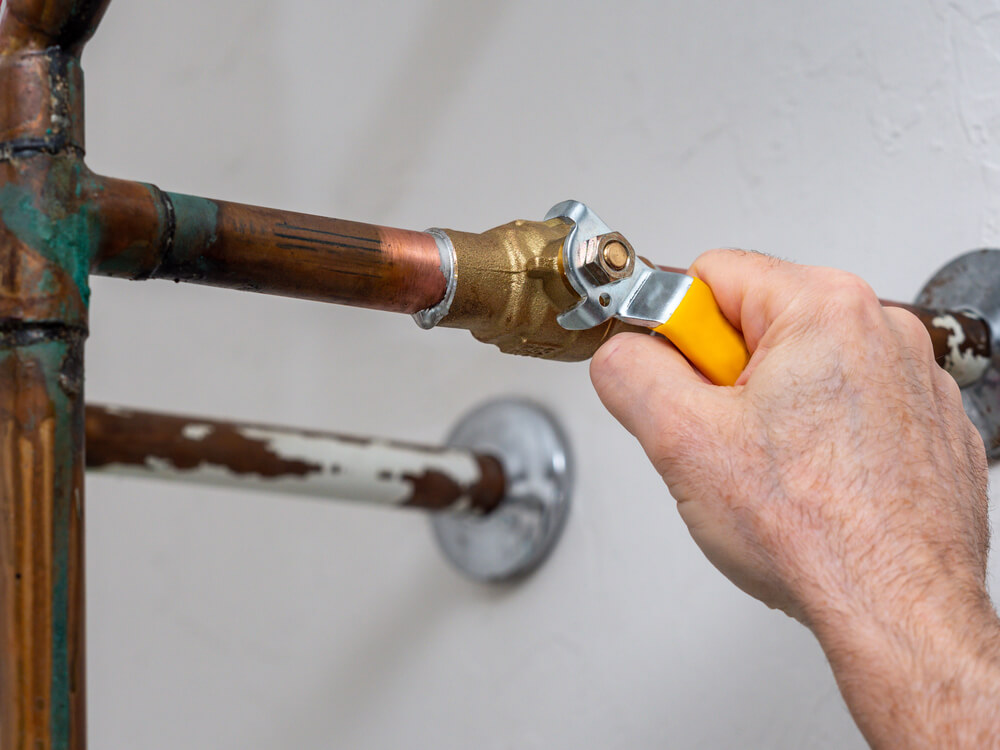A shut-off valve’s purpose is to turn off the water supply to an appliance or fixture, or to the entire home. It comes in handy during emergencies, like a pipe bursting or a fixture leaking.
Water damage is a common occurrence in emergencies, and that’s why you should always know where your shut-off valves are, how they work, and when to use them. It’s also essential to know what to do if yours doesn’t work.
What Is a Shut-Off Valve?
Most people associate a shut-off valve with the main shut-off to the entire building, which stops the water from coming into your home altogether. This is your go-to defense against most plumbing catastrophes and should always be kept in good condition. Whether you have a leaking pipe, a busted water heater, or another emergency, your shut-off valve is what will save you from excessive water damage.
In addition to the main shut-off, buildings will typically have valves at every toilet, faucet, and appliance in your home. These shut-off valves are ideal for a situation involving isolated issues.
If you have a leaking dishwasher, broken faucet knob, or a toilet that won’t stop running, for example, this small shut-off valve will discontinue the water supply to just that location while conserving water to the rest of the house. The localized valves should be used to turn off the water to that specific location whenever maintenance is being performed on it to avoid accidental bursts or floods.
No matter the location, shut-off valves can mean the difference between a minor plumbing fix and significant water damage in the home. That’s why it’s important to inspect these occasionally to ensure they work efficiently.
Types of Shut-Off Valves
Various types of shut-off valves are commonly used in plumbing systems, ranging in different shapes and advantages. Here are some of the most common:
- Gate Valve: These valves control water flow by raising or lowering a gate inside the valve body. They provide a full flow path when fully open but are prone to corrosion and can become difficult to operate over time.
- Ball Valve: Ball valves use a rotating ball with a hole through its center to control water flow. They offer quick and easy operation, reliable sealing, and are less prone to corrosion compared to gate valves.
- Compression Valve: These valves use a threaded stem and nut to compress a rubber or plastic washer against a seat to stop water flow. They are commonly used in older plumbing systems.
- Quarter-Turn Valve: These valves, including ball valves and some types of cartridge valves, can be turned 90 degrees from fully closed to fully open with a quarter turn of the handle. They offer quick and easy operation and are commonly used in modern plumbing installations.
- Stop and Waste Valve: This type of valve combines a shut-off valve with a drain port. It allows water to be drained from the line when the valve is closed, making it useful for winterizing outdoor faucets or pipes.
- Butterfly Valve: Butterfly valves use a rotating disc to control water flow. They are commonly used in large-diameter pipes and industrial applications but are less common in residential plumbing due to their size and cost.
- Pressure-Relief Valve: Pressure-relief valves are designed to automatically release excess pressure from a plumbing system to prevent damage or rupture. They are commonly found on water heaters and in other high-pressure plumbing systems.
Common Valve Issues
What should you do if your valve breaks? This question ultimately depends on what the valve is experiencing. If it’s leaking, pliers can easily tighten the valve up. If it’s stuck, you can try using lubricant to loosen it up. WD-40 or PB Blaster are common lubricants for this type of problem.
Some other common issues include frozen valves, partial closure, or a broken handle or stem. In the case of a frozen valve, you can use a hair dryer or heat gun to gently warm the valve, but be careful not to overheat.
In some cases, valves may not fully close, allowing a small amount of water to continue flowing. This can result in dripping faucets, running toilets, or other water waste.
In the case of a broken handle or stem, it’s best to reach out to a professional plumber.
If you’ve found a shut-off valve that isn’t working, contact Fayette for assistance. Our expert technicians can inspect the valve and determine whether it needs to be replaced. And, because we understand that life happens and you aren’t always going to discover an issue during business hours, we also offer 24/7 emergency plumbing repair services.


 Skip to content
Skip to content

